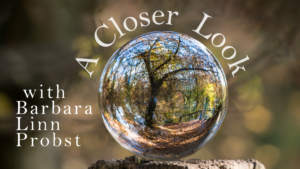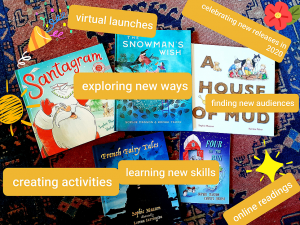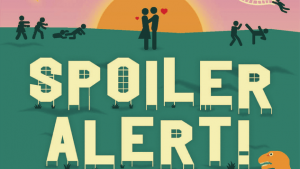Marketing
No matter who publishes your book, your obligation to promote it is inescapable. Every author would rather be writing than promoting so it’s important to make your time flogging your book count. Also, if you’re like me, you try hard not to lose money writing, and that means outsourcing as little as possible. Because social media platforms are the predominant cost-free methods available to us, creating eye-catching graphics is a skill we’d all be wise to optimize.
Luckily, I truly enjoy making graphics, and when I have time or am procrastinating writing, I volunteer my services to friends. Over the years, I have learned a thing or two about promoting books using images, and I’m here to share them with you.
Keep it simple. Eye-catching graphics are not complicated; they are clean. How do you make a clean graphic? Someone who has studied graphic design could explicate the principles, but since that’s not me, I can only tell you what I try to do: create a mood and showcase the cover. If you’re lucky, your cover and title already convey genre and mood. The job of the graphic is to amplify that or to suggest what reading the book would be like. It’s spin, it’s fantasy, it’s advertising. For two friends, I used Canva (https://www.canva.com/) to create two distinct moods. For Jessica Strawser’s upcoming release I echoed the water motif on the cover; it didn’t need more.
For Amy Sue Nathan’s book, I picked up the beach motif and used a less stuffy font appropriate to the tone of the story.
Limit the text. The primary purpose of a graphic is to get attention. The secondary purpose is to convey information. If you try to convey too much, however, you’ll muddy the waters and fall short of both goals. People are scrolling, they are distracted, they are eating lunch and will swipe past a wordy graphic. If you are promoting a giveaway, say “giveaway” and not “enter the first giveaway for my new release.” A brief quote, even a single word (“Extraordinary!”), gets the message across better than two-sentences. If you want to include a link to your website or the book’s page, make it small and stick it in a corner. Links are already in your post, right?
Make your cover the star. Whatever background you choose, ensure it does not compete with your cover.
Read MoreMy latest book, a YA speculative fiction novel titled The Ghost Squad, is out this week. I’m delighted, of course–and thank you so much to WU for helping me celebrate its release with a Take Five interview!
That also got me thinking about new releases, how we go about celebrating them, and the different things authors do to highlight their book to readers, so this what I want to look at, in my first WU post for this new year. In the age of COVID, many of us are trying to come up with ingeniously new ways of celebrating new releases…
In my own case, both in the past and more recently, I’ve done a selection of many things over and above what my publishers have done, and all planned well ahead of release time. For example, in 2020 I did all of the following, to help to highlight my five new releases–it was a big year for new books for me and I had to work pretty hard to try and showcase them! Of course I didn’t do all of these things for each book, just a selection, as appropriate:
These all had varying degrees of success, but most worked quite well. Some were more time-consuming than others, of course. And one of the things I found in 2020 when it came to publicizing my new releases was that though reviews were really hard to come by–harder even than usual–people seemed much more interested in doing author interviews. I was invited to do several over the year, both in video and podcast, as well as being included in video series—readings, talks–initiated by children’s literature organizations specifically for the purpose of supporting authors and illustrators.
In the case of other authors, here are some things that I’ve seen people do:
Read More“My publisher told me that sales numbers the week of publication will make or break my book’s future. Let’s hurry and make sure as much news as possible goes live that week!”
“With my publication date in 3 weeks, I’d like to start PR right away to make a huge splash that day and boost my book’s chances of success.”
Nearly every day I hear comments like this from authors hoping that PR and marketing aimed at their publication date will catapult their new books to overnight success. Here’s the formula they’ve been taught:
“Get the word out ASAP = pique potential readers’ interest right away + drive sales.”
If only it were accurate.
As it turns out, reality is starkly different. Let’s unpack it.
First, getting the word out in and of itself takes time. If you have a publicist, they’ll need to develop a thoughtful strategy and messaging plan. They’ll need to build press lists and prepare marketing materials and press releases. When done well, this is a lengthy process filled with myriad gnarly details that slow things down.
Once communications do start rolling out, recipients need time to process them. Reporters, editors and reviewers get many hundreds of pitches a day sent directly to their inbox. They may not spot your pitch or press release right away. When they do finally see the news about your book (if they do!) they might not be able to focus on it for a while.
Then—if and when they do see the news about your book, and if and when they decide to follow up—lots of things need to happen before a review or interview can go live. Media contacts may need to:
Sure, there are times when things happen much more quickly. But those are rare. I’ve described this process in detail before here on Writer Unboxed.
Once the coverage is out in the world your potential readers need to see it and focus on it. That, too, takes time. At any given nanosecond, your audience, like the rest of us, are all in the midst of a thousand different things.
All of this adds up not to instant interest and sales, but to the beginning of a long, slow trek. Which is why I always say that BOOK PROMOTION IS A MARATHON, NOT A SPRINT.
In the sprint scenario, you race to do everything imaginable—PR, social media, newsletter marketing, signings, etc—over the course of a few months leading up to your publication date, then come to an abrupt halt […]
Read MoreIn this strange stay-at-home year, publicity and marketing for authors has been more difficult than ever. It’s not just that physical in-person launches, events, school visits and festivals have had to be cancelled, postponed or streamlined to be shifted online. It’s also harder to get publicity materials into the usual outlets, and social media has also seemed less receptive to the usual kind of book news. Book people generally have had to invent new ways of connecting with readers and spreading the word about new books whilst providing an entertaining and engaging distraction from the general news.
In my case, as I described in a previous post, I’ve been experimenting with different kinds of online presentations, but what I want to discuss is a form of online presentation which I’ve really enjoyed creating. I call it an illustrated video talk for want of a better, more elegant phrase (any suggestions as to that gratefully accepted!). It’s a mix of PowerPoint slides and audio commentary, turned into a simple video which is easy to make and upload to You Tube or other video channels. The primary focus of these videos is not straight-out book promotion per se–though hopefully they will arouse interest in the book or books discussed in the video. Instead, I intend them to be intriguing, informative and maybe even useful–glimpses into my creative process, inspirations and the writing life generally. Thus they would fit within an overall author strategy, rather than just single-book promotion or even multi-book promotion.
The beauty of these illustrated video talks is that you do not need to be a professional video-maker to create them, or to have access to expensive high-quality equipment. Of course you won’t have the ‘live’ feel of the ‘talking head’ video, but you also avoid issues like mediocre web-cam quality, umpteen takes, large file sizes, etc. And in my opinion you get the ‘storytelling voice’ across more strongly, as there’s less to distract you. Don’t expect them to get you lots of ‘hits’ unless you are very lucky, but do expect that you will be creating some very useful and practical resources, not only to put on your sites and social media, but to give out as links to people who might consider booking you for other kinds of presentations, as well as for school visits, for publishers’ marketing, etc. And they are fun to make!
The basics of it are easy: You write a simple script, use Power Point to create the original series of slides based on important pointers in your script, with illustrations, then record your commentary with the Audio function in PowerPoint (you can also add music if you want). After saving the file in PP, export it to an MP4 format, then upload to YouTube, Vimeo, etc.
Of course there’s more to it it you mean to make something that goes beyond a simple ‘hey, look at this book’ notion. So far I’ve made three of these illustrated video talks: one which looks at the inspiration and process behind the creation of several of my picture books; one about the inspirations and sources behind my new retellings of French fairy tales; and one in a great […]
Read Moreimage by Visionello
Yesterday, I spent most of the day working. In the end, I wrote 40 words. And it was a successful working day, not a failed one; those 40 words will make someone very happy.
A poet, I suppose, might be able to make the same statement, but I haven’t written poetry in years; what I’m talking about here is writing a blurb for a less-established novelist. A lot of time goes into reading an entire book and thinking through how to phrase your praise. Though it’s time-consuming, it’s also one of my favorite things.
If you’re looking for wisdom on requesting a blurb, let me point you to Barbara Lynn Probst’s recent post on the subject: lots of great guidelines and thoughts here. I figured I’d focus instead on what to do once a blurb request comes in. Maybe it’s from an editor or agent through your e-mail; maybe it’s a Twitter or Facebook message from an unknown writer; maybe it’s a verbal request from an acquaintance or friend (remember when we used to see people at conferences? good times). There are four potential responses, each of which I use with different frequency. Let’s walk through them one by one:
Read More
Spoiler alert: this post is not going to talk about COVID-19 or the state of our world and the ways in which we’ve all needed to adjust. But it is going to look at the pandemic as an example of something I’m asked about all the time. You guessed it: spoilers.
Rarely does a week go by when an author does not ask me whether posting a particular snippet with plot information to Facebook, or sharing a description of their main character’s conflicts or fate with a reporter will “give away too much.” In other words, whether it’ll be a spoiler.
Every single time—regardless of the amount of detail being shared—my answer is no.
Though it might sound surprising, in the world of book promotion, more information is…more. And less is…flat. In order to engage people who have not yet picked up your book, there needs to be enough powerful, detailed information to pique their curiosity. Far too often I see authors very carefully opting to give away little more than a publication date, a cover image, the sources of their inspiration and the content of the back cover copy. But in holding back juicy detail, you’re missing opportunities to engage.
Think about it. Details in and of themselves don’t tell the story. To anybody who has not read the book, details are like bait. As the author, you know your own book intimately. You instantaneously connect the dots from each tiny detail to the bigger picture. But that’s only because you know the bigger picture. Future readers have no way to do this.
Here’s how you can artfully weave the right spoilers into shout-outs and other communications about your book:
Be specific
Share juicy details abundantly. In and of themselves, they give little away. Instead, they give a flavor for what makes the characters, the setting, the conflicts and your voice unique. These little tidbits will create intrigue and make people want to know more, not less.
For example, buried in one book we recently promoted is the author’s story of having been fired from her dream job due to sexual discrimination but deciding not to file a claim about it. (You might be wondering why. You can read about that here.) Most authors would want to hold back from sharing the details of a story like this and its outcome in the promotion process for fear that readers will get enough satisfaction from that stand-alone anecdote that they won’t want to read the entire book. But in fact, this tidbit is an intriguing inroad to the book itself, serving to pique curiosity. Doesn’t it make you want to know more?
Read More




















